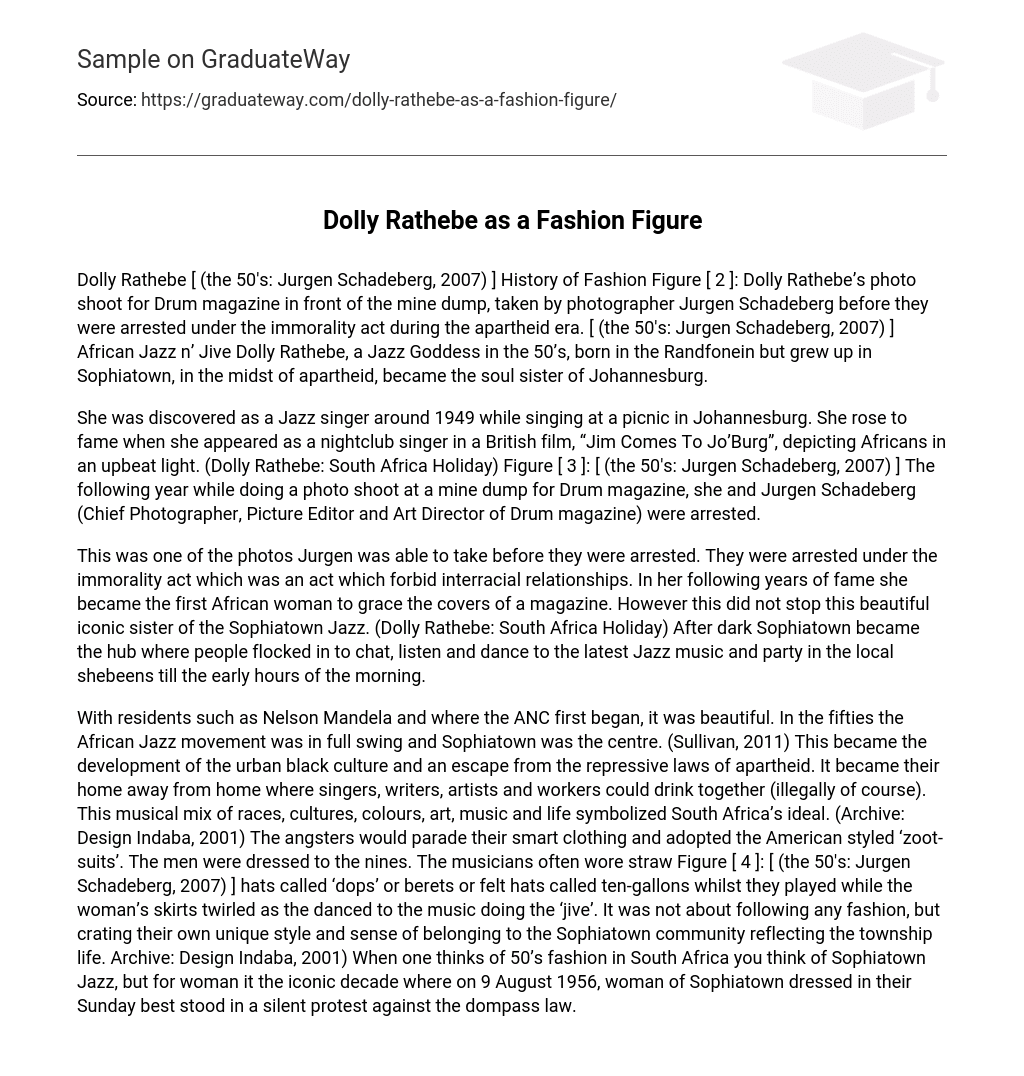Dolly Rathebe’s photo shoot for Drum magazine in front of the mine dump, taken by photographer Jurgen Schadeberg before they were arrested under the immorality act during the apartheid era. African Jazz n’ Jive Dolly Rathebe, a Jazz Goddess in the 50’s, born in the Randfonein but grew up in Sophiatown, in the midst of apartheid, became the soul sister of Johannesburg. She was discovered as a Jazz singer around 1949 while singing at a picnic in Johannesburg. She rose to fame when she appeared as a nightclub singer in a British film, “Jim Comes To Jo’Burg”, depicting Africans in an upbeat light.
The following year while doing a photo shoot at a mine dump for Drum magazine, she and Jurgen Schadeberg (Chief Photographer, Picture Editor and Art Director of Drum magazine) were arrested. This was one of the photos Jurgen was able to take before they were arrested. They were arrested under the immorality act which was an act which forbid interracial relationships.
In her following years of fame she became the first African woman to grace the covers of a magazine. However this did not stop this beautiful iconic sister of the Sophiatown Jazz. (Dolly Rathebe: South Africa Holiday) After dark Sophiatown became the hub where people flocked in to chat, listen and dance to the latest Jazz music and party in the local shebeens till the early hours of the morning.
With residents such as Nelson Mandela and where the ANC first began, it was beautiful. In the fifties the African Jazz movement was in full swing and Sophiatown was the centre. (Sullivan, 2011) This became the development of the urban black culture and an escape from the repressive laws of apartheid. It became their home away from home where singers, writers, artists and workers could drink together (illegally of course). This musical mix of races, cultures, colours, art, music and life symbolized South Africa’s ideal. (Archive: Design Indaba, 2001)
The angsters would parade their smart clothing and adopted the American styled ‘zoot-suits’. The men were dressed to the nines. The musicians often wore straw hats called ‘dops’ or berets or felt hats called ten-gallons whilst they played while the woman’s skirts twirled as the danced to the music doing the ‘jive’. It was not about following any fashion, but crating their own unique style and sense of belonging to the Sophiatown community reflecting the township life. Archive: Design Indaba, 2001) When one thinks of 50’s fashion in South Africa you think of Sophiatown Jazz, but for woman it the iconic decade where on 9 August 1956, woman of Sophiatown dressed in their Sunday best stood in a silent protest against the dompass law.
All of the influential woman in the 50’s wouldn’t dream of leaving the house if they were not dressed their absolute best from head to toe. Although it may have been dark times the silhouettes are still evident in today’s local fashion. Men dressed like gentlemen and Women like ladies with their knee high skirts, string of pearls around their neck, a hat, gloves and heels. This era celebrated femininity and the 1956 women’s march helped solidify women’s presence in local politics, which they participated in while looking feminine,” says David Tlale. (Seabi, 2011)
This era has influenced many trends, from colours to dress lengths to accessories. This is evident in the high waisted swing dresses and pencil-skirts with the skinny belts. One designer which has drawn inspirations from the 50’s look is Stoned Cherry with her high waisted and pencil skirts as well as Abigail Betz’s ‘afternoon-tea dresses’ and Tlale’s tweed suits. Seabi, 2011) In the 1950’s Dior created the ‘new look’ where he designed first his H-line skirt then his A-line skirt.
The difference between the old looks and new looks were that the skirt became shorter. Men began following the Edwardian look dating 50 years before (narrow trousers and close-fitting jackets worn with a small bowler hat) which were exaggerated by the ‘teddy-boys’. The same style could be found in Sophiatown, as the urban culture were looking to the American styles. (Contini, 1965) the 50’s emphasized femininity and the bubbly personality of women.
There was an emphasis on the hourglass silhouette but few of the dresses show any cleavage instead they had a scoop neck or a high collar. Full skirts brought the attention to the hips and the legs, where the hourglass silhouette was constantly accentuated. (1950’s Style Dresses: Enjoy Your Style, 2011)
Bibliography
- 1950’s Style Dresses: Enjoy Your Style. (2011). Retrieved August 11, 2011, from Enjoy Your Style: http://www. enjoy-your-style. com/1950s-style-dresses. html
- About Jurgen: Jurgen Schadeberg. (2007). Retrieved August 11, 2011, from Jurgen Schadeberg: http://www. urgenschadeberg. com/cv. htm
- Archive: Design Indaba. (2001). Retrieved August 11, 2011, from Dsign Indaba: http://www. designindabamag. com/2002/1st/artical02-what. html





